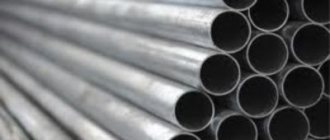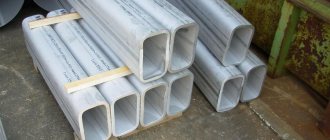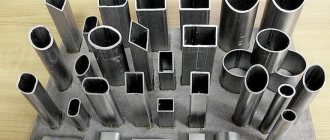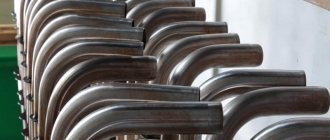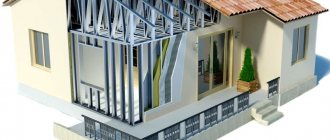Why do we need calculations of pipe parameters?
In modern construction, not only steel or galvanized pipes are used. The choice is already quite wide - PVC, polyethylene (HDPE and LDPE), polypropylene, metal-plastic, corrugated stainless steel.
They are good because they do not have as much mass as their steel counterparts. However, when transporting polymer products in large volumes, it is advisable to know their weight in order to understand what kind of machine is needed.
The weight of metal pipes is even more important - delivery is calculated by tonnage. So it is advisable to control this parameter.
What cannot be measured can be calculated
It is necessary to know the outer surface area of the pipe to purchase paint and thermal insulation materials. Only steel products are painted, because they are susceptible to corrosion, unlike polymer ones. So you have to protect the surface from exposure to aggressive environments.
They are used more often for the construction of fences, frames for outbuildings (garages, sheds, gazebos, cabins), so the operating conditions are difficult, protection is necessary, therefore all frames require painting.
This is where the area of the surface to be painted is required - the outer area of the pipe.
When constructing a water supply system for a private house or cottage, pipes are laid from the water source (well or borehole) to the house - underground.
And still, to keep them from freezing, insulation is required. You can calculate the amount of insulation by knowing the outer surface area of the pipeline.
Only in this case it is necessary to take material with a substantial margin - the joints must overlap with a substantial margin.
The cross-section of the pipe is necessary to determine the throughput - whether this product can carry the required amount of liquid or gas. The same parameter is often needed when choosing the diameter of pipes for heating and plumbing, calculating pump performance, etc.
Inner and outer diameter, wall thickness, radius
Pipes are a specific product. They have an internal and external diameter, since their wall is thick, its thickness depends on the type of pipe and the material from which it is made. Technical specifications often indicate the outer diameter and wall thickness.
Pipe inner and outer diameter, wall thickness
Having these two values, it is easy to calculate the internal diameter - subtract twice the wall thickness from the external one: d = D - 2*S. If you have an outer diameter of 32 mm, a wall thickness of 3 mm, then the inner diameter will be: 32 mm - 2 * 3 mm = 26 mm.
If, on the contrary, there is an internal diameter and wall thickness, but an external one is needed, we add double the stack thickness to the existing value.
With radii (denoted by the letter R) it is even simpler - this is half the diameter: R = 1/2 D. For example, let’s find the radius of a pipe with a diameter of 32 mm. Just divide 32 by two, we get 16 mm.
Vernier caliper measurements are more accurate
What to do if there are no technical data for the pipe? To measure. If special accuracy is not needed, a regular ruler will do; for more accurate measurements, it is better to use a caliper.
Calculation of pipe surface area
The pipe is a very long cylinder, and the surface area of the pipe is calculated as the area of the cylinder. For calculations, you will need a radius (internal or external - depends on what kind of surface you need to calculate) and the length of the segment that you need.
Formula for calculating the side surface of a pipe
To find the lateral area of the cylinder, we multiply the radius and length, multiply the resulting value by two, and then by the number “Pi”, we obtain the desired value. If desired, you can calculate the surface of one meter, which can then be multiplied by the desired length.
For example, let’s calculate the outer surface of a piece of pipe 5 meters long, with a diameter of 12 cm. First, let’s calculate the diameter: divide the diameter by 2, we get 6 cm.
Now all quantities must be reduced to the same units of measurement. Since the area is calculated in square meters, we convert centimeters to meters. 6 cm = 0.06 m.
Next, we substitute everything into the formula: S = 2 * 3.14 * 0.06 * 5 = 1.884 m2. If you round it up, you get 1.9 m2.
Weight calculation
When calculating the weight of a pipe, everything is simple: you need to know how much a linear meter weighs, then multiply this value by the length in meters.
The weight of round steel pipes is in reference books, since this type of rolled metal is standardized. The weight of one linear meter depends on the diameter and wall thickness.
One point: the standard weight is given for steel with a density of 7.85 g/cm2 - this is the type recommended by GOST.
Round Steel Pipe Weight Table
In table D - outer diameter, nominal diameter - inner diameter, And one more important point: the weight of ordinary rolled steel is indicated; galvanized steel is 3% heavier.
Weight table for profiled square pipe
How to calculate cross-sectional area
Formula for finding the cross-sectional area of a round pipe
If the pipe is round, the cross-sectional area should be calculated using the formula for the area of a circle: S = π*R2. Where R is the radius (internal), π is 3.14. In total, you need to square the radius and multiply it by 3.14.
For example, the cross-sectional area of a pipe with a diameter of 90 mm. We find the radius - 90 mm / 2 = 45 mm. In centimeters this is 4.5 cm. We square it: 4.5 * 4.5 = 2.025 cm2, substitute it into the formula S = 2 * 20.25 cm2 = 40.5 cm2.
The cross-sectional area of a profiled pipe is calculated using the formula for the area of a rectangle: S = a * b, where a and b are the lengths of the sides of the rectangle. If we consider the cross-section of the profile to be 40 x 50 mm, we get S = 40 mm * 50 mm = 2000 mm2 or 20 cm2 or 0.002 m2.
How to calculate the volume of water in a pipeline
When organizing a heating system, you may need a parameter such as the volume of water that will fit in the pipe. This is necessary when calculating the amount of coolant in the system. For this case, we need a formula for the volume of a cylinder.
Formula for calculating the volume of water in a pipe
There are two ways: first calculate the cross-sectional area (described above) and multiply it by the length of the pipeline. If we calculate everything according to the formula, we will need the internal radius and the total length of the pipeline. Let's calculate how much water will fit in a system of 32 mm pipes 30 meters long.
First, let's convert millimeters to meters: 32 mm = 0.032 m, find the radius (divide in half) - 0.016 m. Substitute into the formula V = 3.14 * 0.0162 * 30 m = 0.0241 m3. It turned out = a little more than two hundredths of a cubic meter. But we are used to measuring the volume of the system in liters. To convert cubic meters into liters, you need to multiply the resulting figure by 1000. It turns out 24.1 liters.
Outer and inner diameter, wall thickness, radius
The main characteristic of a water pipe is its diameter. Moreover, it is divided into external and internal. The difference between these values, divided in half, is the thickness of the pipe wall.
It is the diameter that determines the pressure with which water will flow from the taps. If the diameter is too small, then with high pressure the water will “hum” in the pipes. In addition, the risk of pipe failure increases.
Selecting the diameter depending on the length for a cottage water supply gives the following results:
- At distances less than 10 m, you can take pipes whose clearance is 10 mm.
- For lengths from 1 to 30 m, take an internal diameter of 20 mm.
- If the pipes have a length of more than 30 m, the diameter should be 32 mm or more.
You can measure the diameter using a caliper. This is the distance between two points that are connected by a straight line running through the center and located around the circumference of the pipe. If the points on the circle constituting the outer edge of the pipe are the outer diameter, on the inner circle – the inner diameter (or the lumen of the pipe).
Diameter can be expressed in metric (mm) or imperial (inch). The first system is used for copper pipes, the second for steel and polymer products. It is easy to convert them into each other: 1 dm is 2.54 mm. You can see the relationship between the most common values in the metric and imperial systems in the proposed table:
It is worth pointing out that the diameter in inches for a polymer pipe will not exactly correspond to these values. The fact is that the wall thickness of polymer and steel pipes is different. And when creating a water pipeline, the coincidence of the internal radii is of greatest importance. That is why the internal radius of a polymer pipe coincides with the same parameter of a metal pipe, but the outer radius is different.
Calculation of pipe parameters: how to correctly calculate the weight, mass and volume of a pipe
Pipeline transport plays a very important role in Russian conditions. Huge quantities of liquid products are pumped through it. In addition to water, liquefied gas, oil and its products and other liquids, in some cases aggressive, are transported.
The capacity of such a product is determined by the diameter of the internal space, for example, for a size of 820 x 10 millimeters, we can determine the working diameter by the ratio D = 820 – 10 x 2 = 800 mm. However, it is better to immediately move on to the generally accepted unit - the meter. With an internal diameter of the product of 0.8 meters, the calculation ratio is as follows:
V = P*r2l
- V – volume;
- P – pi equal to 3.14;
- r – radius;
- l is its length.
However, it makes no sense to calculate the volume of a single product. It is better to immediately apply this ratio to determine the volume of the entire pipeline.
This indicator is important in order to know the amount of pumped product that will remain in the pipeline upon completion of transportation of the required volume. However, pipelines are not used in one-time pumping mode. They are designed for continuous use.
Using the same method, the volumes of cylindrical containers – tanks, barrels and the like – are calculated.
In pipeline transport for highways, electric welded single or double seam pipes with different wall thicknesses are mostly used. To increase the productivity of the pipeline, products are pumped through it under high pressure - up to 130 atmospheres.
Therefore, sheet metal up to 36 millimeters thick is used for production. The main method of connection in pipelines is electric welding, therefore low-carbon steels, such as 09G2S, 09G2FB and others, are used as the manufacturing material.
How to calculate cross-sectional area
Formula for finding the cross-sectional area of a round pipe
If the pipe is round, the cross-sectional area should be calculated using the formula for the area of a circle: S = π*R2. Where R is the radius (internal), π is 3.14. In total, you need to square the radius and multiply it by 3.14.
For example, the cross-sectional area of a pipe with a diameter of 90 mm. We find the radius - 90 mm / 2 = 45 mm. In centimeters this is 4.5 cm. We square it: 4.5 * 4.5 = 2.025 cm2, substitute it into the formula S = 2 * 20.25 cm2 = 40.5 cm2.
The cross-sectional area of a profiled pipe is calculated using the formula for the area of a rectangle: S = a * b, where a and b are the lengths of the sides of the rectangle. If we consider the cross-section of the profile to be 40 x 50 mm, we get S = 40 mm * 50 mm = 2000 mm2 or 20 cm2 or 0.002 m2.
Calculation of weight, mass, pipe volume (and other parameters): formulas and examples
Water supply, heating, sewer, chimney, casing, copper, steel, plastic, metal-plastic, narrow, wide - pipes for various purposes from various materials surround us everywhere. The need to lay new communications or replace old ones arises both during the construction of a house and during ongoing repairs. When drawing up a project for the upcoming work, it would not hurt to arm yourself with a calculator to calculate the weight of the pipe, its mass, volume and other parameters.
Why do you need to calculate pipe parameters?
Preliminary calculation of pipe parameters is necessary in many cases. For example, for proper communication of the pipeline with other elements of the system. When working with pipes, designers and installers use indicators such as:
- pipeline permeability;
- heat loss;
- amount of insulation;
- amount of material for corrosion protection;
- roughness of the inner surface of the pipe, etc.
As a result, it is possible to determine the exact number of pipes required for a particular system, as well as their optimal characteristics. Correct calculations eliminate unnecessary costs for purchasing and transporting material and allow the substances in the pipeline to move at a given speed for the most efficient use of the system.
This table provides some useful information about the characteristics of different types of pipes that will help you select the appropriate designs needed to create a pipeline
In heating systems, the diameter of the pipes significantly depends on the permissible speed. An example of this kind of calculation is presented in the video:
Calculations of various pipe parameters
In order to correctly calculate the main parameters of pipes, the following indicators should be determined:
- the material from which the pipe is made;
- type of pipe section;
- internal and external diameter;
- Wall thickness;
- pipe length, etc.
Some of the data can be obtained simply by measuring the structure. A lot of useful information is contained in certification documents, as well as in various reference books and GOSTs.
How to find out the diameter and volume of a pipe?
Some calculation formulas are familiar to every schoolchild. For example, if you need to determine the diameter of a specific pipe, you should measure its circumference. To do this, you can use a measuring tape that seamstresses use. Alternatively, wrap the pipe with another suitable tape and then measure the resulting length using a ruler.
Next, we use the formula for circumference:
Laying options
The first thing to do when making calculations is to divide the total area of the room into equal squares. The contour (one branch) of the pipe cannot be more than 120 m. Therefore, determining the quadrature will allow you to choose the optimal way to place the water floor. In practice, there are several options for laying a pipeline:
| Way | Peculiarities | Scheme |
| Snake | It is used in small, strictly rectangular rooms. Such a system is installed as an additional system to radiator heating. Minus - heating occurs unevenly. The highest temperature is in places near the collector at the bends | |
| Double snake | Laying like a “snake”, but two pipes laid in parallel at once | |
| Corner snake | The pipes begin to be laid out from the corners. In different options, the maximum filling occurs in 1-2 corners, or in all 4 | |
| Snail | The most popular method of laying a pipeline, since it has virtually no heat loss, even if the system is designed for a very large cold room with no alternative heating | |
| Edge zones | Areas near the walls consume more heat, so here the step between pipes is reduced to 10 cm (with a step to the middle of the room of 150 mm). Increased heat transfer along the edge is carried out in cases where furniture is not planned to be installed near the walls |
Laying methods are often combined. This depends on the size and functionality of the room, its shape, available alternative heating options, the number of external walls and other things.
Types of installation
Warm water floors are mounted either on a concrete screed or on ready-made specialized materials.
In the first case, you will need to postpone laying the finishing floor covering for 28 days (time for the concrete screed to dry). In the second situation, going through all the stages of floor placement will not take much time.
Thermal insulation profile boards
The simplest and most affordable way to install heated floors. It does not require the involvement of a specialist; it is quite possible to carry out all the work yourself.
The slabs are special insulation mats measuring 3x30x100 cm. Pipes are laid in the grooves, and the floor covering is placed on the convex areas. The slabs do not absorb moisture and, accordingly, do not change their characteristics. When heating floor elements, no harmful substances are released into the atmosphere.
No concrete screed is required. Use additional flooring under linoleum or floor tiles made of gypsum fiber sheets. Their thickness is at least 2 cm.
Slatted or modular panels
Modular panels made of chipboard or slatted are used as the basis for heated floors in wooden buildings. The thickness of the sheets is 2.2 cm with aluminum channels for piping.
Panels with a length of 15 to 30 cm and a width of 13, 18, 28 cm are used. The plates are equipped with special latches for precise fixation of pipes. If linoleum is chosen as the floor covering, then an additional layer of gypsum fiber boards is laid on the pipes. This will reduce unnecessary heat loss.
Installation of slatted panels is identical to installation of modular chipboard. The width of the slats is 2.8 cm. The slats are stuffed onto the logs (the distance between them is from 40 to 60 cm) in increments of up to 2 cm. For additional thermal insulation, mineral fiber wool or, in some cases, polystyrene foam is chosen.
It is the holes between chipboards or slats, lined with aluminum plates with grooves, that are intended for laying heat-conducting pipes at the bottom. When installing this type of system, the greatest difficulty is installing logs, slabs or slats on them. This requires basic skills and experience.
Concrete screed
Concrete screed as the basis for laying heated floor elements is the most reliable design for protecting the entire system from damage. But the desired effect and durability are achieved if the process is carried out in stages, according to all the rules:
- Using a hammer drill, all unevenness on the “rough” floor is eliminated.
- A waterproofing material is selected, cut into strips, and spread “overlapping”, extending by 30 cm. The waterproofing extends to the walls by 15 cm. The joints are taped with construction tape.
- Lay a thermal insulation layer.
- The junction of the proposed screed and the wall is taped with damper tape. When the elements heat up, the screed will expand, and the tape will compensate for the changing distance.
- To increase strength, a reinforcing mesh is laid.
- Choose a method for laying the pipe and attach it to the fittings. Fastening is done with plastic clips.
- Pressure testing is carried out with water to control the operation of the system.
- Special beacons are installed for direction.
- Cement is poured.
In cases where the system is not installed on the ground floor and there is a heated room under the floor, the thermal insulation layer should be made of expanded polystyrene with contour connectors and a thickness of less than 50 mm.

